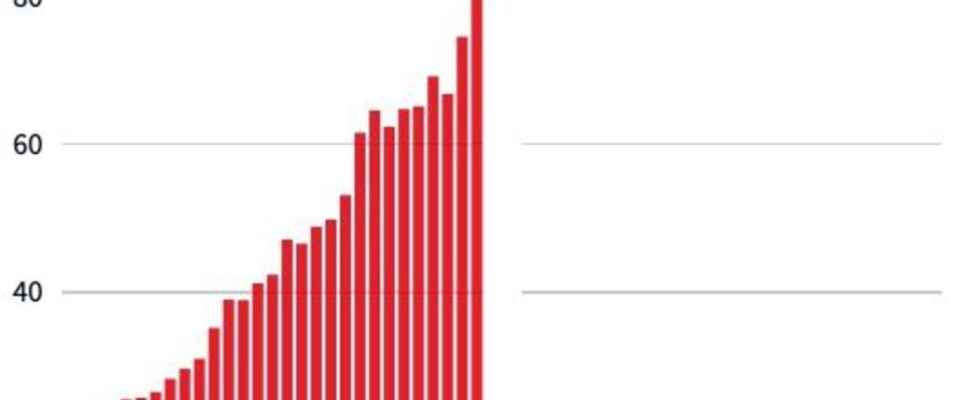The first images provided by Moscow have something to impress: rocket-launching trucks – the famous “Stalin’s organs” – progressing in a row of onions in the snow; tanks and artillery firing; take-off fighter jets and the commissioning of batteries of S-400, a mobile anti-aircraft system. On the soil of its Belarusian ally, and jointly with it, Russia began Thursday, February 10, military exercises of an unprecedented scale. NATO warned that it was “the largest Russian deployment since the Cold War”, with 30,000 fighters.
This demonstration of force, the end of which is officially set for February 20, does it foreshadow its next use? The scenario is considered with seriousness by the Western chancelleries. On the eve of the maneuvers, Washington reported “more than 100,000” soldiers stationed near the Ukrainian border by Russia, noting that it “continues to strengthen its capabilities”.
The face-to-face between Kiev and Moscow is like David against Goliath. Because the Russian army, in recent years, has been considerably modernized, in terms of organization and equipment, thanks to the income from the sale of gas and oil. Its budget amounted to 67 billion dollars in 2020 – ten times more than that of Ukraine -, against 17.5 billion when Vladimir Putin came to power in 1999. The troops he has today do not have much to do with the young conscripts in threadbare uniforms, barely trained and poorly fed, who had been sent to the front in Chechnya. Undermined by the collapse of the USSR, the heiress of the Red Army was then in complete disrepair.
Under Vladimir Putin, military spending has steadily increased.
L’Express/Dario Ingiusto
Indiscipline and disorganization
The reform campaign really began in 2008 when Moscow, coming to the aid of the self-proclaimed republic of South Ossetia, won a blitzkrieg against small Georgia. “The operation brought to light the indiscipline of the troops and their disorganization, as well as material problems, recalls Isabelle Facon, deputy director of the Foundation for Strategic Research and author of The New Russian Army (The Inventory, 2021). To communicate with their command, some Russian soldiers had used the telephones of journalists.” So many shortcomings experienced as a humiliation by Vladimir Putin, convinced that the return of Russia to the forefront of the international scene passes through military power.
Once in power, the head of the Kremlin launched certain sophisticated armament programs (missiles, planes, radars) and accelerated the professionalization of the workforce, while reducing military service to one year. Result: “in 2020, for 225,000 conscripts, largely called upon to supply the reserve, there are 405,000 contract workers, better paid than before and better trained in equipment”, specifies Isabelle Facon. Emphasis was also placed on training, with the resumption in 2009 of annual strategic exercises involving a large number of troops.
The Syrian experience
Better prepared and more flexible, this new army proved itself in the mid-2010s. First in Ukraine in 2014, even if Moscow has always denied the presence of its soldiers in the secessionist territories of Donbass. Then, from 2015, in support of Bashar al-Assad’s regime. Over the rotations, most air force pilots have carried out missions in Syria, like many officers and special forces. “This made it possible to gain experience, in particular in the use of air support in coordination with ground units, and to test advanced armaments,” explains Gustav Gressel, Russia specialist at the European Council on International Relations.
Technological progress should also allow the Russian army to inflict significant damage on Ukraine, even before one of its soldiers sets foot there. “Its air raids and artillery fire with precision munitions, its magnetic jamming and cyber attack capabilities are able to neutralize Ukrainian command centers and limit the ability of their troops to move and communicate. “, estimates Mathieu Boulègue, specialist in the region at the Chatham House Institute.
Card
Dario Ingiusto / L’Express
What pave the way for an invasion, as may suggest the deployment, in recent weeks, of thousands of armored vehicles near the border. Although such an operation risks placing the Russian army in a perilous situation. “The Ukrainian forces are more motivated, better organized than in 2014 and have equipment provided by Western countries, which have contributed to their training, indicates Isabelle Facon. Enough to cause harm to their adversaries.” Especially since Kiev, aware of the imbalance of forces, is actively preparing the population for an insurrection.
The military capabilities of the Russian Army.
L’Express/Dario Ingiusto
The accumulation of dead, on the Russian side, could awaken bad memories within the population, traumatized by the fiasco of the war in Afghanistan (1979-1989), which cost the lives of 26,000 Soviet soldiers. The shock could even be greater: in Ukraine, facing the Russian military, there will be “hostile civilian populations who look like members of their family and speak the same language”, underlines Anna Lebedev, teacher-researcher, specialist in social post-Soviet. “I am not convinced that the soldiers are prepared for this, even though the command will have carried out ideological work beforehand,” she adds.
Russian and Ukrainian Armed Forces.
L’Express/Dario Ingiusto
Because Ukraine has changed in ten years. Nationalism grew stronger outside the lost territories of Crimea and Donbass. “Putin no longer has the means of influence he had before 2014, when part of the Ukrainians, in the east of the country, cultivated mistrust vis-à-vis Kiev, estimates Anna Colin Lebedev. population and the war have fueled animosity towards Russian power and even Russians in general.” The occupation of part of Ukraine, made possible thanks to a major renovation of its army, could quickly turn into a nightmare for Vladimir Putin.
